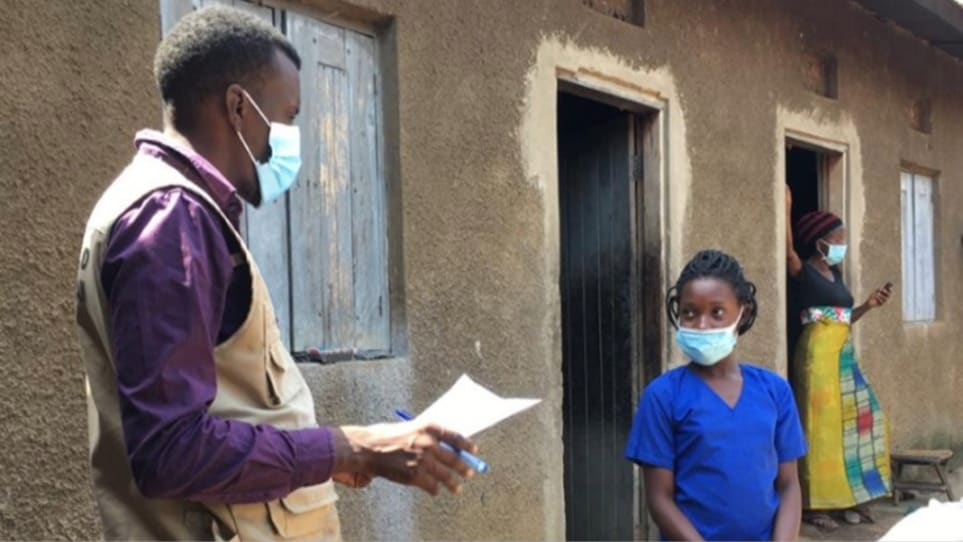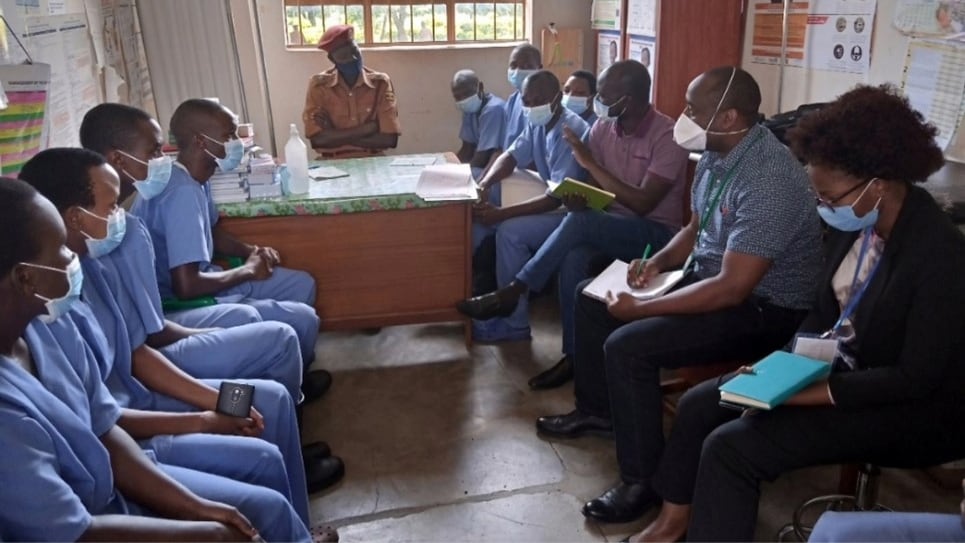At a glance
- During Uganda's first COVID-19 wave, health facilities were strained due to outbreaks in high-risk settings like hospitals and prisons.
- The Uganda Public Health Fellowship Program , supported by CDC, lead investigations, developed national guidelines for home-based care , and offered recommendations to stop the spread of COVID-19 in prisons.
- The findings led to improved home-based care practices and recommended preventive measures.
Uganda's First COVID-19 Wave Strains Health Facilities

The rapid increase in COVID-19 cases during Uganda's first wave in 2020 put enormous stress on the country's health facilities and services. Many outbreaks occurred in high-risk settings, where overcrowding is common, such as hospitals and prisons. As the first wave continued across Uganda, public health interventions to stop the spread of COVID-19 became even more critical.
An important program that addresses public health threats like COVID-19 is the Uganda Public Health Fellowship Program (PHFP), a two-year Field Epidemiology Training Program supported by the U.S. Centers for Disease Control and Prevention (CDC). Throughout the pandemic, Uganda's PHFP fellows have been involved in many COVID-19 outbreak investigations, and two are highlighted below.
Public Health Fellows Help Develop National Guidelines for COVID-19 Home-Based Care
At the start of the pandemic, the common practice in Uganda was to hospitalize everyone who tested positive for COVID-19. This practice was highly effective at containing the outbreak, but it was expensive and strained hospital bed capacity. As facilities quickly filled up, Uganda was forced to shift to a home-based care (HBC) approach, with family members typically providing the care. However, there were no national guidelines for HBC best practices, making this approach challenging to implement.
In November 2020 alone, more than 750 COVID-19 cases were reported in Kasese District and the adjacent Kabarole District, which are both in western Uganda. Without clear and unified guidelines on best practices, it became difficult to slow the spread of COVID-19 among communities with patients in HBC. Thus, many of these cases occurred among household members of patients in HBC settings.
Leading a COVID-19 Investigation in Two Districts
Two epidemiology fellows from the Uganda PHFP led an investigation regarding household COVID-19 transmission in Kasese and Kabarole districts with support from the district health officers and CDC. The fellows found that having more than one person per room (i.e., a "crowded house"), having an infected household member with a cough, and being in close contact with the infected person increased the risk of other household members becoming infected with the virus that causes COVID-19. In addition, household members with high blood pressure had an increased risk of infection.
Mr. Geofrey Amanya, a 2022 Uganda PHFP graduate and lead investigator, stated, "It was easy to test the initial cases and put them under home isolation, but the lack of training on how to do home-based care, poor or no symptom monitoring, and lack of knowledge about at-risk populations increased the number and severity of cases in these homes."
Presenting the Study Findings to Develop National Guidelines
Mr. Amanya presented the study findings to the HBC office of the Uganda Ministry of Health. The HBC office used these findings to develop HBC guidelines for Uganda. The guidelines state that household members with COVID-19 should take extra care to isolate themselves from people at high risk of getting very sick from COVID-19, which includes people who are older, are immunocompromised, have certain disabilities, or have underlying medical conditions. The guidelines also state that a separate room with adequate ventilation is necessary for a home to be considered suitable for HBC.
The work of the Uganda PHFP fellows, with support from the district health officers and CDC, provided the Uganda Ministry of Health with data needed to address deficiencies in HBC practice guidelines.
Why it matters:
Preventing COVID-19 in Ugandan Prisons: Simple Interventions Work

COVID-19 outbreaks also pose severe threats in prisons. Because of crowded conditions, prevention measures like physical distancing are not always feasible.
On September 3, 2020, an inmate in quarantine at the Moroto Prison, located in northeast Uganda, tested positive for SARS-CoV-2, the virus that causes COVID-19. The facility's staff and its entire population of 692 inmates were then tested. In total, 202 inmates and 8 staff members tested positive. With guidance from CDC, two epidemiology fellows from the Uganda PHFP investigated the outbreak in Moroto Prison to identify how COVID-19 was introduced and spread, and they offered recommendations to stop the disease from spreading further.
Understanding the Course of the Outbreak
The PHFP fellows investigated and learned that COVID-19 was introduced into Moroto Prison from an inmate who had become infected during a recent stay in a nearby regional referral hospital. He had been tested before leaving the hospital but returned to the prison quarantine cell before the test results were available. The quarantine cell was overcrowded with 65 other inmates, making physical distancing challenging. By the time the test result came back positive, COVID-19 had already spread to the rest of the facility, likely through shared food service staff.
The Importance of Preventive Measures
"This outbreak occurred at the same time as another prison outbreak in Uganda and had nearly identical results," said Dr. Julie Harris, CDC Resident Advisor for the PHFP fellows in Uganda. "Both studies found that access to masks and handwashing reduced the infection risk by 70% to 80%. We shared these findings with the Uganda Prison System to recommend that they make masks and handwashing stations available to inmates at all prisons."
The team's recommendations have positioned the Uganda Prison System to protect the country's citizens better and help prevent further outbreaks.
Did you know?
Workforce development programs like Uganda's PHFP add crucial value to local and national health systems. Together, Uganda's PHFP fellows and CDC have highlighted the importance of timely disease detection, outbreak response, and the accessibility and implementation of simple prevention measures. The work of PHFP graduates helps advance global health security, better protecting the population's health during the COVID-19 pandemic.
